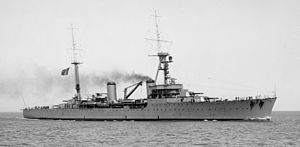 Tourville in 1929
| |
| History | |
|---|---|
| Name | Tourville |
| Namesake | Anne Hilarion de Tourville |
| Ordered | 1 July 1924 |
| Builder | Arsenal de Lorient |
| Laid down | 4 March 1925 |
| Launched | 24 August 1926 |
| Completed | 1 December 1928 |
| Commissioned | 5 May 1928 |
| In service | 12 Mar 1929 |
| Out of service | 8 March 1962 |
| Fate | Towed from Brest to Toulon for scrapping, 15 January 1963 |
| General characteristics | |
| Class and type | Duquesne class |
| Type |
|
| Displacement | |
| Length | 191 m (627 ft) overall 185 m (607 ft) between perpendiculars |
| Beam | 19 m (62 ft) |
| Draught | 6.32 m (20.7 ft) |
| Propulsion |
|
| Speed | 34 knots (63 km/h) (designed) |
| Range |
|
| Complement | 605 |
| Armament |
|
| Armour |
|
| Aircraft carried | 2 FBA 17 and CAMS 37A (superseded by GL-810 then Loire-Nieuport 130 |
| Aviation facilities | 1 catapult |
Tourville was the second ship of the Duquesne class cruisers of the French Navy. During the interwar period she served in the Mediterranean while taking periodic cruises to show the Flag. During the war she was on blockade duty in the mid Atlantic then the Mediterranean. She was interned for three years at Alexandria, rejoining the war effort in 1943. Again assigned to blockade duty in the Mid Atlantic at Dakar. Post war she aided in the restoration of French Colonial rule in French Indochina until placed in reserve in 1947. She remained in reserve until condemned for disposal in 1962.
She was named to honour Anne-Hilarion de Costentien, comte de Tourville (1642 – 1701) who served with distinction under King Louis XIV. He fought against the British and Dutch at the battles of Beachy Head (French: Beveziers) and Barfluer. On 27 June 1693 defeated an English convoy commanded by George Rooke at Cape St Vincent and made Marshall of France.[4]